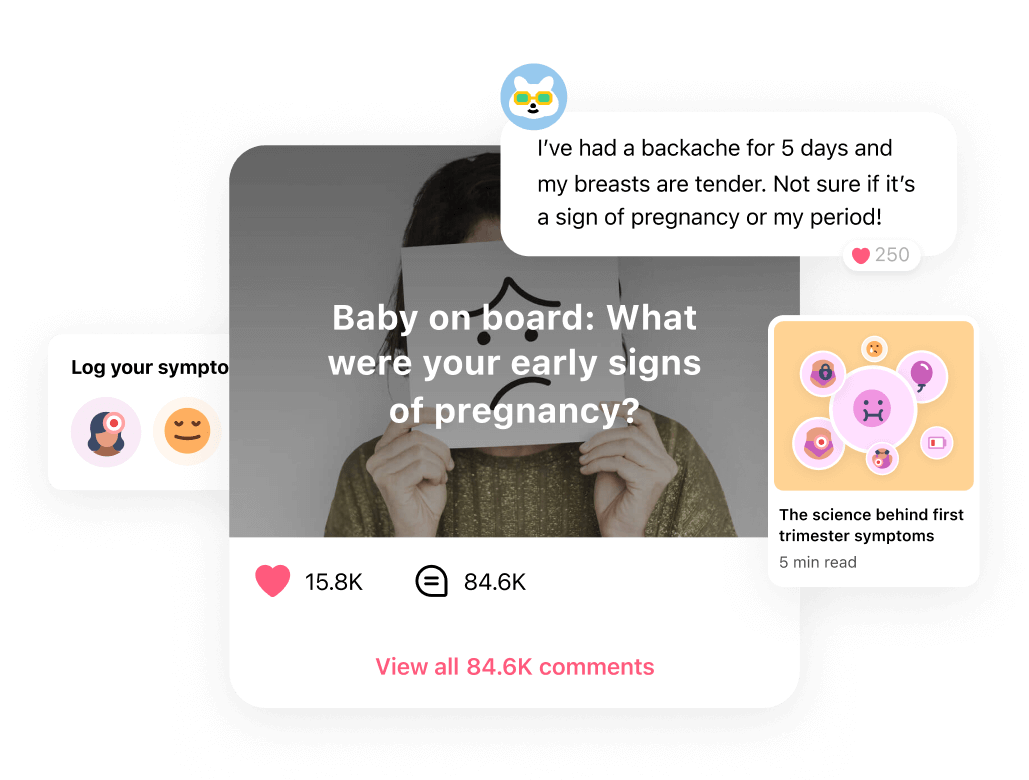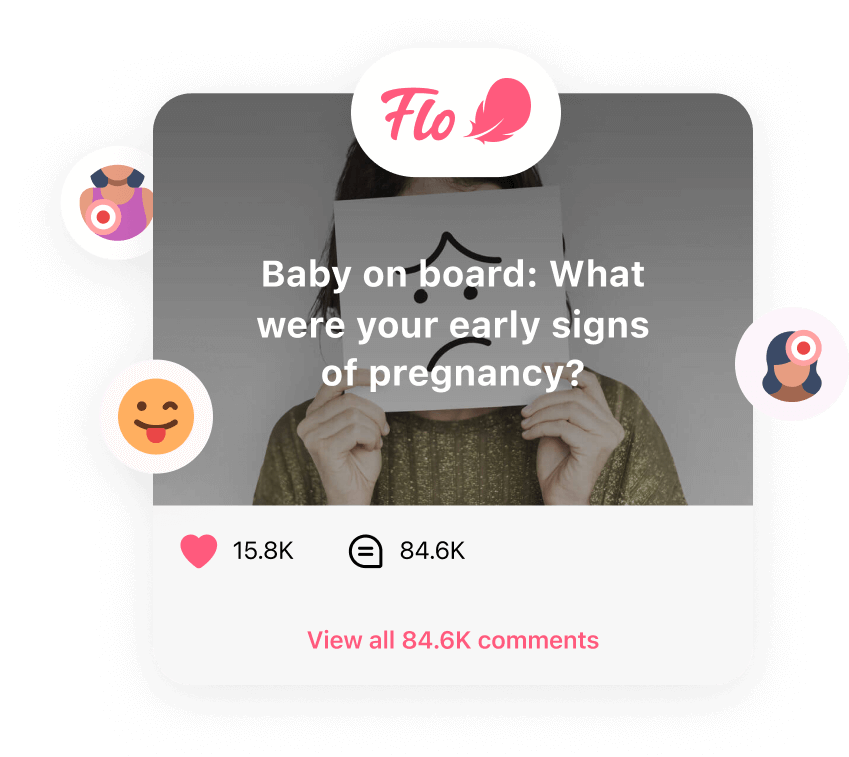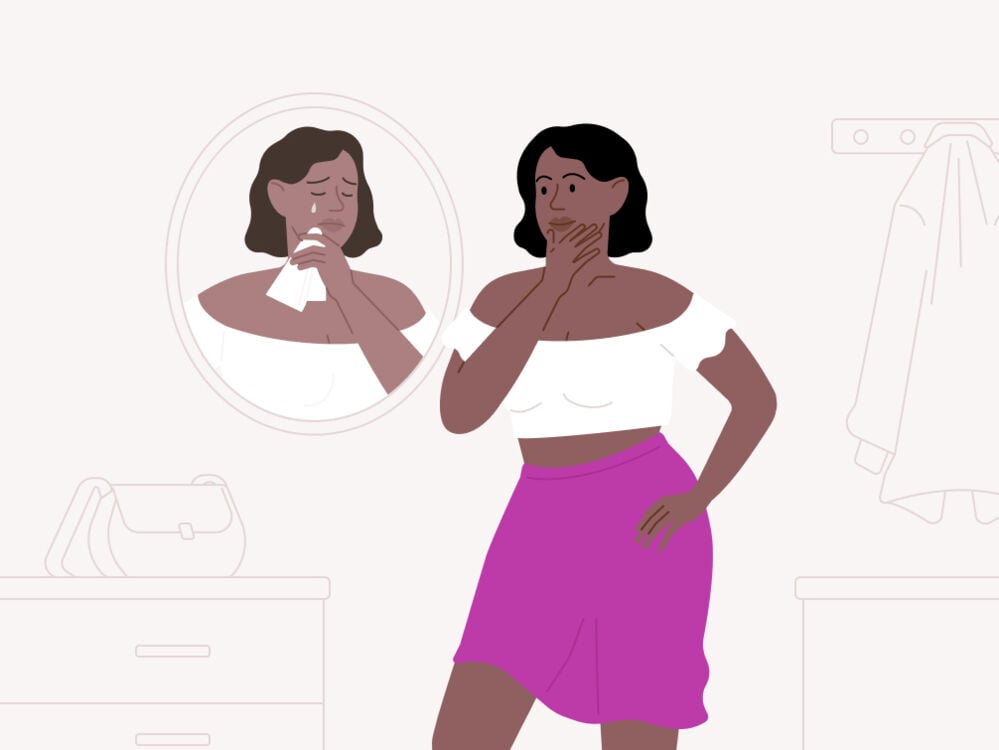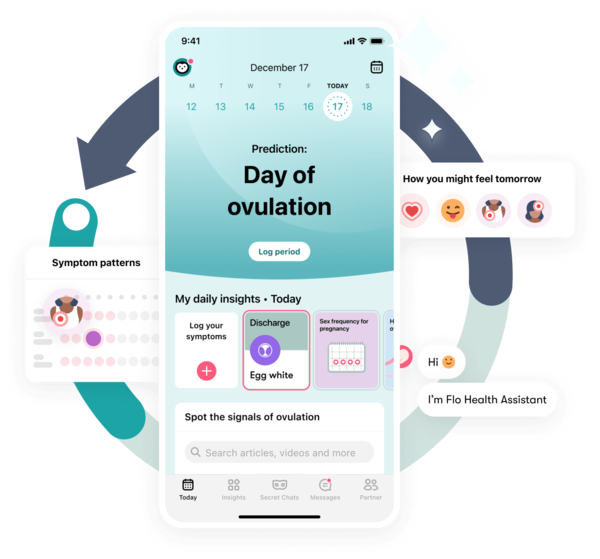It’s normal to be looking for signs that you’re pregnant, but is it too early to tell? Here’s the lowdown on 13 DPO, including whether you can take a test.
-
Tracking cycle
-
Getting pregnant
-
Pregnancy
-
Help Center
-
Flo for Partners
-
Anonymous Mode
-
Flo app reviews
-
Flo Premium New
-
Secret Chats New
-
Symptom Checker New
-
Your cycle
-
Health 360°
-
Getting pregnant
-
Pregnancy
-
Being a mom
-
LGBTQ+
-
Quizzes
-
Ovulation calculator
-
hCG calculator
-
Pregnancy test calculator
-
Menstrual cycle calculator
-
Period calculator
-
Implantation calculator
-
Pregnancy weeks to months calculator
-
Pregnancy due date calculator
-
IVF and FET due date calculator
-
Due date calculator by ultrasound
-
Medical Affairs
-
Science & Research
-
Pass It On Project New
-
Privacy Portal
-
Press Center
-
Flo Accuracy
-
Careers
-
Contact Us
13 DPO: Are there any pregnancy symptoms at 13 days past ovulation?


Every piece of content at Flo Health adheres to the highest editorial standards for language, style, and medical accuracy. To learn what we do to deliver the best health and lifestyle insights to you, check out our content review principles.
At 13 days past ovulation (or 13 DPO), you may be a few days away from your period and be feeling some of the symptoms often linked to the arrival of your monthly bleed.
However, if you’re trying to get pregnant, you might have already noticed that premenstrual symptoms and the signs of early pregnancy can feel pretty similar. It can be hard to tell the difference between the two, so being on high alert for every new ache is totally normal.
Since many doctors recommend waiting until the first day of your missed period (around 14 days past ovulation if you have a 28-day cycle) before taking a pregnancy test, you don’t have long to go. However, this time can feel like an all-consuming waiting game.
So, here’s what you might be feeling at 13 DPO, including what might be happening with your body right now and when you can take a test.
Key takeaways
- Implantation (when a fertilized egg attaches to the lining of your uterus) marks the start of pregnancy. As this typically happens between 6 and 10 DPO, you might already be pregnant.
- You may not feel too different at 13 DPO. This is to be expected. If you are pregnant, then it’s still very early days.
- It’s still recommended that you wait until 14 DPO (or the first day of your missed period) to take a pregnancy test. At-home tests work by looking for the pregnancy hormone human chorionic gonadotropin (hCG) in your pee. Your hCG levels start low at the start of your pregnancy but rise rapidly. By the first day of your missed period, you should have enough hCG to get an accurate pregnancy test result.
- Your hCG levels may be high enough to be picked up at 13 DPO, but if you test too soon, you risk getting a false negative.

 Over
7.8M
ratings averaging
4.8/5
*
Over
7.8M
ratings averaging
4.8/5
*
Understand your body’s signals with the Flo app
- Chat with others who are trying to get pregnant.
- Get trusted information on signs of pregnancy from 100+ medical experts.
- Log your symptoms and learn what they could be trying to tell you.
 Over
7.8M
ratings averaging
4.8/5
*
Over
7.8M
ratings averaging
4.8/5
*

Trying to conceive?
The Flo app can help you through the two-week wait.

 Over
7.8M
ratings averaging
4.8/5
*
Over
7.8M
ratings averaging
4.8/5
*
Understand your body’s signals with the Flo app
- Chat with others who are trying to get pregnant.
- Get trusted information on signs of pregnancy from 100+ medical experts.
- Log your symptoms and learn what they could be trying to tell you.
13 DPO: What to expect
If you’re 13 DPO, it means that 13 days ago, one of your ovaries released an egg to be potentially fertilized by a sperm. It can be hard to picture where you are in your cycle at 13 DPO, so let’s break it down.
You can think of your cycle as two parts or phases:
- The follicular phase: The first part of your menstrual cycle is called your follicular phase. It starts on the first day of a new period and lasts for around 14 days if you have a 28-day cycle. Everyone’s cycle length is slightly different, but yours would be considered normal if it’s between 21 and 35 days long. During this time, your estrogen levels rise, and the lining of your uterus thickens to help with implantation. Your ovaries also prepare an egg to be released during ovulation.
- The luteal phase: The second phase of your cycle is called your luteal phase. It starts from around day 14 of your cycle — around the time that you ovulate. Just like the length of your cycle, the date that you ovulate is personal to you. You can track it using an app like Flo. During this time, your progesterone levels rise in preparation for a potential pregnancy, and if you have a 28-day cycle, 13 DPO is right at the end of your luteal phase.
If you did get pregnant this cycle, then it’s likely that a fertilized egg attached to the lining of your uterus around six to 10 days after you ovulated (or 6 to 10 DPO). This means that at 13 DPO, you might already be 1 week pregnant.
After implantation, your body starts to grow your placenta. This is a whole new organ that supports your developing fetus and releases the pregnancy hormone hCG. This is the hormone that pregnancy tests detect in your urine.
While your hCG levels start low, at the beginning of pregnancy, they rapidly rise. This is why doctors recommend that you wait at least until the first day of your missed period before doing a test. By this time, your hCG levels should be high enough to give you an accurate result. So can you take a test at 13 DPO?
Can I take a pregnancy test at 13 DPO, or is it too early?
You may be a few days away from the start of your period, and if you’re trying for a baby, this might be the time you’ve been counting down to. At this stage, you’re so close to the best time to take a pregnancy test.
Waiting until the first day of your missed period to take a pregnancy test can feel like you’re in limbo. However, it’s important to give your body enough time to produce enough hCG to be detected on an at-home urine test. This means that 13 DPO is still technically too early. “HCG is detectable in the blood about six to 11 days after conception, but it takes slightly longer to appear on at-home pregnancy tests that measure hCG in urine,” explains Dr. Nazaneen Homaifar, obstetrician and gynecologist, Inova Health System, Washington, DC, US.
Holding off from taking a test can feel really frustrating and nerve racking, but try to fall back on the things that you know make you feel better. If it would put your mind at ease, buy some pregnancy tests in advance. Speak to your friends, family, and partner about how you’re feeling and rely on your comfort TV shows and movies to take your mind off the wait.
Pregnancy symptoms at 13 DPO
Understanding the signs and symptoms of early pregnancy and knowing what happens during the luteal stage of your cycle might help you spot when something feels a little different.
However, thanks to shifting hormones, premenstrual symptoms can mimic many of the early signs of pregnancy you might experience at 13 DPO. Premenstrual symptoms are sometimes grouped under the umbrella term premenstrual syndrome (PMS). So, how do you tell the difference between PMS and pregnancy?
Here are some of the things you might be feeling at 13 DPO and, perhaps more importantly, why:
Mood swings
If you feel irritable or upset around 13 DPO, then you might assume it means your period is on its way. Your hormones fluctuate around this time, so you might feel more sensitive than usual. Try to be gentle with yourself. Hormone changes in early pregnancy can also mean that mood changes are pretty common during your first trimester, too.

Spotting
Have you ever noticed light bleeding between your periods? This could be spotting. Lots of different things can cause spotting, including fluctuations in your hormones, changes in hormonal contraception, or irritation after sex. It’s usually nothing to worry about, but it’s worth booking a checkup with your doctor if you’re concerned. At 13 DPO, you may also be about to start your period if you have a 28-day cycle, and bleeding around this time may just be your monthly bleed starting.
Spotting could also be a sign of implantation. When a fertilized egg attaches to the lining of your uterus, it may cause a little bit of light bleeding.
Nausea
Feeling queasy at 13 DPO? This could be because of fluctuations in your hormones. Nausea during your luteal phase is sometimes described as period nausea and is pretty common.
However, nausea could also be a sign of early pregnancy. You’ll likely have heard tales of morning sickness (although it can happen at any time of day) or pregnancy sickness. As your hCG levels rise, it might leave you running for the bathroom.
Breast pain
As your period approaches, you might notice changes in the way your boobs look and feel. This is due to hormone fluctuations during your luteal phase. Breast pain and tenderness is sometimes referred to as cyclical breast pain.
As your hormones change during early pregnancy, your boobs may also feel sore or swollen. In preparation for milk production, the ducts in your breasts can grow, which may make them feel more sensitive.
Fatigue
Have you been reaching for a blanket at 5 p.m.? This is pretty common at the end of your luteal phase as your body prepares for your period and your hormones fluctuate. Allow yourself to have an afternoon nap every so often if you can. Similarly, fatigue has also been linked to early pregnancy. As your progesterone levels rise, it can leave you feeling more tired than usual.
Take a quiz
Find out what you can do with our Health Assistant
13 DPO and no symptoms
If you’ve been trying to get pregnant, then you may be a pro at symptom spotting by 13 DPO. However, differentiating between the symptoms of early pregnancy and typical signs that your period is on the way isn’t easy — as we’ve seen.
You also might not feel any different at 13 DPO, and this is totally normal. No two pregnancies are the same, and some people don’t experience any pregnancy symptoms for a few weeks. If you haven’t noticed anything yet, it doesn’t mean you aren’t expecting.
More FAQs
What are the symptoms of 13 DPO with a BFP?
There are lots of abbreviations associated with trying for a baby. “BFP” or “big fat positive” simply means getting a positive pregnancy test. The symptoms of early pregnancy and PMS can look pretty similar, so the best thing to do is wait until the first day of your missed period to take a test.
Can a blood test detect pregnancy at 13 DPO?
While 13 DPO might be a little bit early to do an at-home urine pregnancy test, you might be able to tell if you’re pregnant at 13 DPO using a blood test. This is because blood tests are slightly more sensitive than urine tests and can detect very small levels of hCG very early on in pregnancy, sometimes as early as 7 to 10 DPO. It’s best to wait until the first day of a missed period to take an at-home urinary pregnancy test. If you get a positive result, your doctor may confirm your pregnancy with a blood test.
Can you get a faint line at 13 DPO?
If you take a pregnancy test and get a faint line at 13 DPO, congratulations! This means that you are likely to be pregnant. However, before you make any big announcements, it’s still best to confirm your pregnancy with another test after a missed period. The line on your pregnancy test should darken as your hCG levels increase.


Hey, I'm Anique
I started using Flo app to track my period and ovulation because we wanted to have a baby.


The Flo app helped me learn about my body and spot ovulation signs during our conception journey.


I vividly
remember the day
that we switched
Flo into
Pregnancy Mode — it was
such a special
moment.
Real stories, real results
Learn how the Flo app became an amazing cheerleader for us on our conception journey.
References
“1st Trimester Pregnancy: What to Expect.” Mayo Clinic, 8 Mar. 2022, www.mayoclinic.org/healthy-lifestyle/pregnancy-week-by-week/in-depth/pregnancy/art-20047208.
“Am I Pregnant?” Cleveland Clinic, my.clevelandclinic.org/health/articles/9709-pregnancy-am-i-pregnant. Accessed 16 Nov. 2023.
Bastian, Lori A., and Haywood L. Brown. “Clinical Manifestations and Diagnosis of Early Pregnancy.” UpToDate, 16 Mar. 2023, www.uptodate.com/contents/clinical-manifestations-and-diagnosis-of-early-pregnancy.
Betz, Danielle, and Kathleen Fane. “Human Chorionic Gonadotropin.” StatPearls, StatPearls Publishing, 14 Aug. 2023, www.ncbi.nlm.nih.gov/books/NBK532950/.
“Doing a Pregnancy Test.” NHS, www.nhs.uk/pregnancy/trying-for-a-baby/doing-a-pregnancy-test/. Accessed 29 Nov. 2023.
“First Trimester Fatigue.” Johns Hopkins Medicine, www.hopkinsmedicine.org/health/conditions-and-diseases/first-trimester-fatigue. Accessed 29 Nov. 2023.
“Follicular Phase.” Cleveland Clinic, my.clevelandclinic.org/health/body/23953-follicular-phase. Accessed 29 Nov. 2023.
Gudipally, Pratyusha R., and Gyanendra K. Sharma. “Premenstrual Syndrome.” StatPearls, StatPearls Publishing, 17 July 2023, www.ncbi.nlm.nih.gov/books/NBK560698/.
“Home Pregnancy Tests: Can You Trust the Results?” Mayo Clinic, 23 Dec. 2022, www.mayoclinic.org/healthy-lifestyle/getting-pregnant/in-depth/home-pregnancy-tests/art-20047940.
“Implantation Bleeding: Common in Early Pregnancy?” Mayo Clinic, 19 Apr. 2022, www.mayoclinic.org/healthy-lifestyle/pregnancy-week-by-week/expert-answers/implantation-bleeding/faq-20058257.
Jeanmonod, Rebecca, et al. “Vaginal Bleeding.” StatPearls, StatPearls Publishing, 13 Nov. 2023, www.ncbi.nlm.nih.gov/books/NBK470230/.
Keye, William R., Jr. “Premenstrual Syndrome (PMS).” Encyclopedia of Endocrine Diseases, Elsevier, 2004, pp. 73–75.
“Luteal Phase.” Cleveland Clinic, my.clevelandclinic.org/health/articles/24417-luteal-phase. Accessed 29 Nov. 2023.
“Menstrual Cramps.” Mayo Clinic, 30 Apr. 2022, www.mayoclinic.org/diseases-conditions/menstrual-cramps/symptoms-causes/syc-20374938.
“Menstrual Cycle: What’s Normal, What’s Not.” Mayo Clinic, 22 Apr. 2023, www.mayoclinic.org/healthy-lifestyle/womens-health/in-depth/menstrual-cycle/art-20047186.
“Is Nausea during Pregnancy a Good Sign?” Mayo Clinic, 26 Oct. 2021, www.mayoclinic.org/healthy-lifestyle/pregnancy-week-by-week/expert-answers/nausea-during-pregnancy/faq-20057917.
“Normal Breast Development and Changes.” Johns Hopkins Medicine, www.hopkinsmedicine.org/health/conditions-and-diseases/normal-breast-development-and-changes. Accessed 29 Nov. 2023.
“Placenta.” Cleveland Clinic, my.clevelandclinic.org/health/body/22337-placenta. Accessed 29 Nov. 2023.
“Pregnancy Test.” MedlinePlus, medlineplus.gov/lab-tests/pregnancy-test/. Accessed 29 Nov. 2023.
“Pregnancy Tests.” Cleveland Clinic, my.clevelandclinic.org/health/diagnostics/9703-pregnancy-tests. Accessed 29 Nov. 2023.
“Premenstrual Syndrome (PMS).” Mayo Clinic, 25 Feb. 2022, www.mayoclinic.org/diseases-conditions/premenstrual-syndrome/symptoms-causes/syc-20376780.
“Progesterone.” Cleveland Clinic, my.clevelandclinic.org/health/body/24562-progesterone. Accessed 21 Nov. 2023.
Sayle, Amy E., et al. “A Prospective Study of the Onset of Symptoms of Pregnancy.” Journal of Clinical Epidemiology, vol. 55, no. 7, July 2002, pp. 676–80, https://doi.org/10.1016/s0895-4356(02)00402-x.
Su, Ren-Wei, and Asgerally T. Fazleabas. “Implantation and Establishment of Pregnancy in Human and Nonhuman Primates.” Advances in Anatomy, Embryology, and Cell Biology, vol. 216, 2015, pp. 189–213, https://doi.org/10.1007%2F978-3-319-15856-3_10.
“The Big Fat Positive (BFP).” Tommy’s, www.tommys.org/pregnancy-information/blogs-and-stories/im-pregnant/pregnancy-insider-blog/big-fat-positive-bfp. Accessed 29 Nov. 2023.
Thiyagarajan, Dhanalakshmi K., et al. “Physiology, Menstrual Cycle.” StatPearls, StatPearls Publishing, 24 Oct. 2022, www.ncbi.nlm.nih.gov/books/NBK500020/.
History of updates
Current version (15 December 2023)
Published (30 April 2019)
In this article

Get your personal guide to fertility
-
Learn how to read your body's ovulation signals
-
Find daily conception tips from our experts
-
Chat with others who are trying to get pregnant




